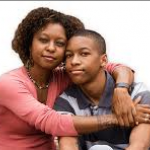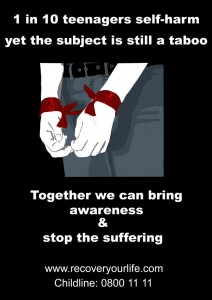You’re a parent or guardian and just found out that your child self-injures. You’ll probably react with a mixture of anger, shock, guilt, worry, and anxiety. You might be convinced that your child is suicidal. Self-harm by itself isn’t suicidal behaviour. But if the emotional distress that causes self-injury continues, it can cause suicidal thoughts.
 Self-injury is an attempt at instant relief from an emotional pain. Actions can range from pulling hair out in clumps, bruising, cutting, to the drinking of bleach. The physical pain of self-harm is often easier to deal with than the emotional pain behind it.
Self-injury is an attempt at instant relief from an emotional pain. Actions can range from pulling hair out in clumps, bruising, cutting, to the drinking of bleach. The physical pain of self-harm is often easier to deal with than the emotional pain behind it.
The way you first react will impact your child’s trust in you. Here’s what you as a parent or guardian should do to help a child who self-injures:
DON’T
- Get angry or show disgust. Negativity alienates your child. Ultimatums only drive your child away from you.
- Deny the problem. It’s not your child’s problem or just one of his/her ‘things’. It’s not a fad, social statement or a phase your child will grow out of.
- Hide sharp objects. If your child wants to self-injure, he/she will find a way.
- Blame yourself. Unless you know you have a hand in the emotional distress, taking blame just takes emotional energy away from where it’s needed – your child.
- Assume your child is okay once in treatment. Recovery from self-injury can take months, maybe even years.
DO
- Stay calm. Freaking out won’t solve anything. It will just alienate your child and close all lines of communication.
- Talk. Be non-judgmental. Ask “Why are you doing this to yourself?”
- Take the problem seriously. It’s not about attention-seeking or a growing pain.
- Ask if your relationship could be improved. If you’re part of the blame then take responsibility.
- Seek treatment for your child. Accompany your child to the doctor or counsellor but don’t be pushy about privacy. Your child will open up to you when she/he is ready.
- Find the triggers. Focus on the underlying problems rather than just the injury.
- Trust your child. Your child is the same person you knew and loved before. Self-injury is just a small part of them. You’ll have to balance the instinct to monitor or trust your child.
- Treat your child as usual, especially when other people are in the house.
 If you see scratches or cuts that you can treat at home, do so. But burns and other serious injuries need medical attention.
If you see scratches or cuts that you can treat at home, do so. But burns and other serious injuries need medical attention.
Self-injury treatment is a long process. It includes medication with family and individual therapy over a period of time. Setbacks happen even after therapy ends. Be prepared to continue your non-judgmental support.
Finally, don’t be afraid to ask for help. There’s many terrific websites and forums dealing with self-injury for parents and guardians. One is LifeSIGNS – Self-Injury Guidance & Network Support. It’s a UK organization with easy to use information sheets for anyone dealing with self-injury. Thanks to LifeSIGNS for supplying the above information.
Depression Help by Terezia Farkas is a mental health blog. Terezia’s bestseller Heart of Love Evolution – Surviving Depression is available on Amazon. Website: www.tereziafarkas.com Follow on Twitter.


